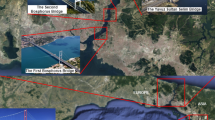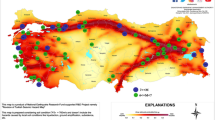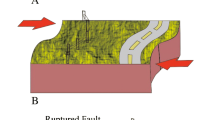Abstract
Chloride ion penetration, which leads to corrosion of steel reinforcement, is the leading cause of offshore reinforced concrete bridge deterioration. Global warming would accelerate the process of chloride ion penetration and then structural degradation. In China, durability design code for concrete structures has been issued in 2008, and some thresholds of design parameters have been specified to mitigate corrosion in concrete bridge. However, influence of global warming on structure durability was not considered in the issued code. This would overestimate the durability of concrete structures. In this paper, a reliability based method was adopted to evaluate the influence of climate change on the durability of offshore RC bridges considering the acceleration of chloride ion penetration caused by temperature rise. Two climate change scenarios according to IPCC report were considered to define the global warming. A baseline scenario, in which the mean average temperature equals to that of the year 2000, were defined. It is found that the amount of chloride ion on the surface of reinforcing steel bar in the global warming scenarios are 6%-15% higher than that of structure in the baseline scenario. Meanwhile, the probability of corrosion initiation and corrosion damage increased also. In 2100, structures in environmental categories III-C and III-F, designed according to Chinese codes, can no longer adapt the impact of climate change on structure. Comparison of reliability of improved and pre-improved structure was conducted to verify the effectiveness of the proposed improvement measures.
Similar content being viewed by others
References
Akiyama, M., Frangopol, D. M., and Yoshida, I. (2012). “Time-dependent reliability analysis of existing RC structures in a marine environment using hazard associated with airborne chlorides.” Engineering Structures, Vol. 32, No. 11, pp. 3768–79, DOI: 10.1016/j.engstruct.2010.08.021.
Duan, A., Dai, J. G., and Jin, W. L. (2014). “Probabilistic approach for durability design of concrete structures in marine environments.” Journal of Materials in Civil Engineering, Vol. 27, No. 2, pp. A4014007, DOI: 10.1061/(ASCE)MT.1943-5533.0001023.
DuraCrete (1998). Modelling of degradation, DuraCrete-probabilistic performance based durability design of concrete structrues. EU-brite EuRam III. Contract BRPR-CT95-0132. Project BE95-1347/R4-5. pp. 174.
DuraCrete (2000). Statistical quantification of the variables in the limit state functions. Dura Crete-probabilistic performance based durability design of concrete structures, EU-brite EuRam III. Contract BRPRCT95-0132, Project BE95-1347/R9, 130.
EI Maaddawy, T. and Soudki, K. A. (2007). “A model for prediction of time from corrosion initiation to corrosion cracking.” Cement and Concrete Composites, Vol. 29, No. 3, pp. 168–175, DOI: 10.1016/j.cemconcomp.2006.11.004.
Enright, M. P. and Frangopol, D. M. (1998). “Probabilistic analysis of resistance degradation of reinforced concrete bridge beams under corrosion.” Structural Engineering, Vol. 20, No. 11, pp. 960–971, DOI: 10.1016/S0141-0296(97)00190-9.
Intergovernmental Panel on Climate Change (IPCC) (2014). Fifth assessment report of the intergovernmental panel in climate change. London: Cambridge University Press.
Li, Y., Lu, D., and Sheng, H. (2012). “Fatigue reliability analysis on cable of cable-stayed bridge under random vehicle load and wind load.” China Journal of Highway and Transport, Vol. 25, No. 2, pp. 60–66. (in Chinese)
Ministry of Housing and Urban-Rural Development of the People’s Republic of China (MOHURD) (2008). Code for durability design of concrete structures. GB/T 50476, China Architecture and Building Press, Beijing (in Chinese).
Mohamed, N., Boulfiza, M., and Evitts, R. (2013). “Corrosion of carbon steel and corrosion-resistant rebars in concrete structures under chloride ion attack.” Journal of Materials Engineering and Performance, Vol. 22, No. 3, pp. 787–795, DOI:10.1007/s11665-012-0314-0.
Moss R. H., Edmonds J. A., Hibbard K. A., Manning M. R., Rose S. K., Vuuren D. P., Carter T. R., Emori S., Kainuma M., Kram T., Meehl G. A., Mitchell J. F. B., Nakicenovic N., Riahi K., Smith S. J., Stouffer R. J., Thomson A.M., Weyant J.P., and Wilbanks T. J. (2010). “The next generation of scenarios for climate change research and assessment.” Nature, Vol. 463, pp.747–756, DOI: 10.1038/nature08823.
Peng, J. and Shao, X. (2009). “CO2 emission, climate change and their effects on corrosion initiation time and time-dependent reliability of concrete structures.” Journal of Highway and Transportation Research and Development, Vol. 26, No. 10, pp. 76–81. (in Chinese)
Peng, L. and Stewart, M. G. (2014). “Climate change and corrosion damage risks for reinforced concrete infrastructure in China.” Structure and Infrastructure Engineering, Vol. 12, No. 4, pp. 1–18, DOI: 10.1080/15732479.2013.858270.
Skeet, J., Kriviak, G., and Chichak, M. (1994). Service Life Predication of Protective System for Concrete Bridge Decks in Alerta. Edmonton, Alberta, Canada: Alberta Transportation and Utilities, Research & Development.
Stewart, M. G., Wang, X., and Nguyen, M. N. (2011). “Climate change impact and risks of concrete infrastructure deterioration.” Engineering Structures, Vol. 33, No. 4, pp. 1326–37, DOI: 10.1016/j.engstruct.2011.01.010.
Stewart, M. G., Wang, X., and Nguyen, M. N. (2012). “Climate change adaptation for corrosion control of concrete infrastructure.” Structural Safety, Vol. 35, No. 3, pp. 29–39, DOI: 10.1016/j.strusafe.2011.10.002.
Talukdar, S., Banthia, N., and Grace, J. R. (2012a). “Carbonation in concrete infrastructure in the context of global climate change-Part 1: Experimental results and model development.” Cement and Concrete Composites, Vol. 34, pp. 924–930, DOI: 10.1016/j.cemconcomp.2012.04.011.
Talukdar, S., Banthia, N., Grace, J. R., and Cohen, S. (2012b). “Carbonation in concrete infrastructure in the context of global climate change-Part 2: Canadian urban simulations.” Cement and Concrete Composites, Vol. 34, pp. 931–935, DOI: 10.1016/j.cemconcomp.2012.04.012.
Thoft-Christensen, P. (2000). Stochastic modelling of the crack initiation time for reinforced concrete structures. Department of Building Technology and Structural Engineering, Aalborg University.
Yoon, I. S., Copuroglu, O., and Park, K. B. (2007). “Effect of global climatic change on carbonation progress of concrete.” Atmospheric Environment, Vol. 41, pp. 7274–85, DOI: 10.1016/j.atmosenv.2007.05.028.
Author information
Authors and Affiliations
Corresponding author
Rights and permissions
About this article
Cite this article
Xie, HB., Wang, YF., Gong, J. et al. Effect of Global Warming on Chloride Ion Erosion Risks for Offshore RC Bridges in China. KSCE J Civ Eng 22, 3600–3606 (2018). https://doi.org/10.1007/s12205-018-1547-8
Received:
Revised:
Accepted:
Published:
Issue Date:
DOI: https://doi.org/10.1007/s12205-018-1547-8




